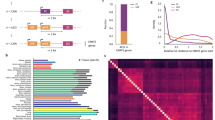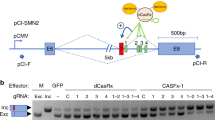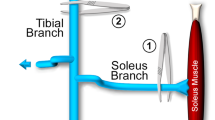Abstract
Spinal muscular atrophy (SMA) is a relatively common neurodegenerative disease caused by homozygous loss of the survival motor neuron 1 (SMN1) gene1. Humans possess a linked, nearly identical gene, SMN2, which produces a functional SMN protein but at levels insufficient to compensate for loss of SMN1 (refs. 1,2). A C/T transition at position +6 in exon 7 is all that differentiates the two genes, but this is sufficient to prevent efficient exon 7 splicing in SMN2 (refs. 2,3). Here we show that the C/T transition functions not to disrupt an exonic splicing enhancer (ESE) in SMN1 (ref. 4), as previously suggested, but rather to create an exonic splicing silencer (ESS) in SMN2. We show that this ESS functions as a binding site for a known repressor protein, hnRNP A1, which binds to SMN2 but not SMN1 exon 7 RNA. We establish the physiological importance of these results by using small interfering RNAs to reduce hnRNP A protein levels in living cells and show that this results in efficient SMN2 exon 7 splicing. Our findings not only define a new mechanism underlying the inefficient splicing of SMN2 exon 7 but also illustrate more generally the remarkable sensitivity and precision that characterizes control of mRNA splicing.
This is a preview of subscription content, access via your institution
Access options
Subscribe to this journal
Receive 12 print issues and online access
$209.00 per year
only $17.42 per issue
Buy this article
- Purchase on Springer Link
- Instant access to full article PDF
Prices may be subject to local taxes which are calculated during checkout




Similar content being viewed by others
References
Lefebvre, S. et al. Identification and characterization of a spinal muscular atrophy-determining gene. Cell 80, 155–165 (1995).
Monani, U.R. et al. A single nucleotide difference that alters splicing patterns distinguishes the SMA gene SMN1 from the copy gene SMN2. Hum. Mol. Genet. 8, 1177–1183 (1999).
Lorson, C.L., Hahnen, E., Androphy, E.J. & Wirth, B. A single nucleotide in the SMN gene regulates splicing and is responsible for spinal muscular atrophy. Proc. Natl. Acad. Sci. USA 96, 6307–6311 (1999).
Cartegni, L. & Krainer, A.R. Disruption of an SF2/ASF-dependent exonic splicing enhancer in SMN2 causes spinal muscular atrophy in the absence of SMN1. Nat. Genet. 30, 377–384 (2002).
Lorson, C.L. & Androphy, E.J. An exonic enhancer is required for inclusion of an essential exon in the SMA-determining gene SMN. Hum. Mol. Genet. 9, 259–265 (2000).
Hofmann, Y., Lorson, C.L., Stamm, S., Androphy, E.J. & Wirth, B. Htra2-β1 stimulates an exonic splicing enhancer and can restore full-length SMN expression to survival motor neuron 2 (SMN2). Proc. Natl. Acad. Sci. USA 97, 9618–9623 (2000).
Tacke, R., Tohyama, M., Ogawa, S. & Manley, J.L. Human Tra2 proteins are sequence-specific activators of pre-mRNA splicing. Cell 93, 139–148 (1998).
Manley, J.L. & Tacke, R. SR proteins and splicing control. Genes Dev. 10, 1569–1579 (1996).
Caceres, J.F., Stamm, S., Helfman, D.M. & Krainer, A.R. Regulation of alternative splicing in vivo by overexpression of antagonistic splicing factors. Science 265, 1706–1709 (1994).
Wang, J. & Manley, J.L. Overexpression of the SR proteins ASF/SF2 and SC35 influences alternative splicing in vivo in diverse ways. RNA 1, 335–346 (1995).
Wang, J., Takagaki, Y. & Manley, J.L. Targeted disruption of an essential vertebrate gene: ASF/SF2 is required for cell viability. Genes Dev. 10, 2588–2599 (1996).
Wang, J., Xiao, S.H. & Manley, J.L. Genetic analysis of the SR protein ASF/SF2: interchangeability of RS domains and negative control of splicing. Genes Dev. 12, 2222–2233 (1998).
Caputi, M., Mayeda, A., Krainer, A.R. & Zahler, A.M. hnRNP A/B proteins are required for inhibition of HIV-1 pre-mRNA splicing. EMBO J. 18, 4060–4067 (1999).
Del Gatto-Konczak, F., Olive, M., Gesnel, M.C. & Breathnach, R. hnRNP A1 recruited to an exon in vivo can function as an exon splicing silencer. Mol. Cell. Biol. 19, 251–260 (1999).
Matter, N. et al. Heterogeneous ribonucleoprotein A1 is part of an exon-specific splice-silencing complex controlled by oncogenic signaling pathways. J. Biol. Chem. 275, 35353–35360 (2000).
Hou, V.C. et al. Decrease in hnRNP A/B expression during erythropoiesis mediates a pre-mRNA splicing switch. EMBO J. 21, 6195–6204 (2002).
Burd, C.G. & Dreyfuss, G. RNA binding specificity of hnRNP A1: significance of hnRNP A1 high-affinity binding sites in pre-mRNA splicing. EMBO J. 13, 1197–1204 (1994).
Bilodeau, P.S., Domsic, J.K., Mayeda, A., Krainer, A.R. & Stoltzfus, C.M. RNA splicing at human immunodeficiency virus type 1 3′ splice site A2 is regulated by binding of hnRNP A/B proteins to an exonic splicing silencer element. J. Virol. 75, 8487–8497 (2001).
Mayeda, A., Munroe, S.H., Caceres, J.F. & Krainer, A.R. Function of conserved domains of hnRNP A1 and other hnRNP A/B proteins. EMBO J. 13, 5483–5495 (1994).
Hutchison, S., LeBel, C., Blanchette, M. & Chabot, B. Distinct sets of adjacent heterogeneous nuclear ribonucleoprotein (hnRNP) A1/A2 binding sites control 5′ splice site selection in the hnRNP A1 mRNA precursor. J. Biol. Chem. 277, 29745–29752 (2002).
Hofmann, Y. & Wirth, B. hnRNP-G promotes exon 7 inclusion of survival motor neuron (SMN) via direct interaction with Htra2-β1. Hum. Mol. Genet. 11, 2037–2049 (2002).
Young, P.J. et al. SRp30c-dependent stimulation of survival motor neuron (SMN) exon 7 inclusion is facilitated by a direct interaction with hTra2 β1. Hum. Mol. Genet. 11, 577–587 (2002).
Tange, T.O., Damgaard, C.K., Guth, S., Valcarcel, J. & Kjems, J. The hnRNP A1 protein regulates HIV-1 tat splicing via a novel intron silencer element. EMBO J. 20, 5748–5758 (2001).
Cartegni, L., Chew, S.L. & Krainer, A.R. Listening to silence and understanding nonsense: exonic mutations that affect splicing. Nat. Rev. Genet. 3, 285–298 (2002).
Tacke, R. & Manley, J.L. Determinants of SR protein specificity. Curr. Opin. Cell Biol. 11, 358–362 (1999).
Dreyfuss, G., Kim, V.N. & Kataoka, N. Messenger-RNA-binding proteins and the messages they carry. Nat. Rev. Mol. Cell Biol. 3, 195–205 (2002).
Wilkinson, M.F. & Shyu, A.B. RNA surveillance by nuclear scanning? Nat. Cell Biol. 4, E144–E147 (2002).
Tacke, R. & Manley, J.L. The human splicing factors ASF/SF2 and SC35 possess distinct, functionally significant RNA binding specificities. EMBO J. 14, 3540–3551 (1995).
Santoro, S.W. & Joyce, G.F. A general purpose RNA-cleaving DNA enzyme. Proc. Natl. Acad. Sci. USA 94, 4262–4266 (1997).
Elbashir, S.M., Harborth, J., Weber, K. & Tuschl, T. Analysis of gene function in somatic mammalian cells using small interfering RNAs. Methods 26, 199–213 (2002).
Acknowledgements
We thank Y. Takebayashi for technical assistance, C.L. Lorson for advice on cloning SMN1 and SMN2 minigene constructs, R. Tacke for providing human Tra2α and Tra2β cDNAs, H.J. Okano for mouse HuD cDNA, J. Kohtz for antibodies to ASF/SF2 and I. Boluk for help preparing the manuscript. This work was supported by grants from the US National Institutes of Health and Families of SMA.
Author information
Authors and Affiliations
Corresponding author
Ethics declarations
Competing interests
The authors declare no competing financial interests.
Rights and permissions
About this article
Cite this article
Kashima, T., Manley, J. A negative element in SMN2 exon 7 inhibits splicing in spinal muscular atrophy. Nat Genet 34, 460–463 (2003). https://doi.org/10.1038/ng1207
Received:
Accepted:
Published:
Issue Date:
DOI: https://doi.org/10.1038/ng1207
This article is cited by
-
Benchmarking splice variant prediction algorithms using massively parallel splicing assays
Genome Biology (2023)
-
Spinal muscular atrophy
Nature Reviews Disease Primers (2022)
-
Heat increases full-length SMN splicing: promise for splice-augmenting therapies for SMA
Human Genetics (2022)
-
Self-organizing maps with variable neighborhoods facilitate learning of chromatin accessibility signal shapes associated with regulatory elements
BMC Bioinformatics (2021)
-
Systematic analysis of the relationship between ovarian cancer prognosis and alternative splicing
Journal of Ovarian Research (2021)



